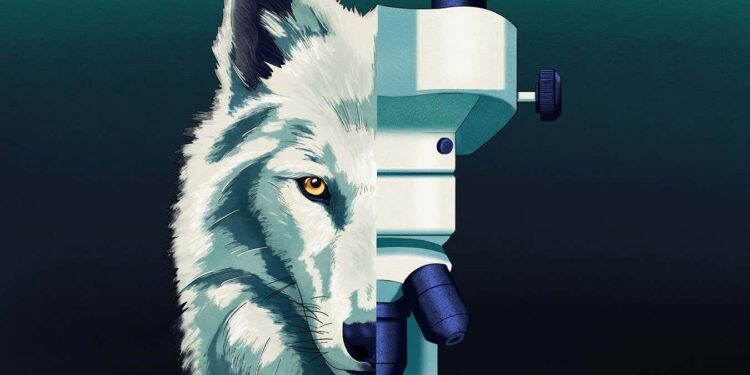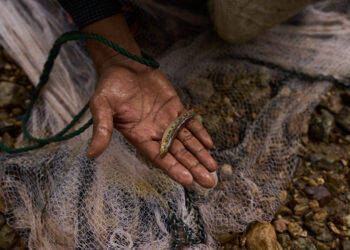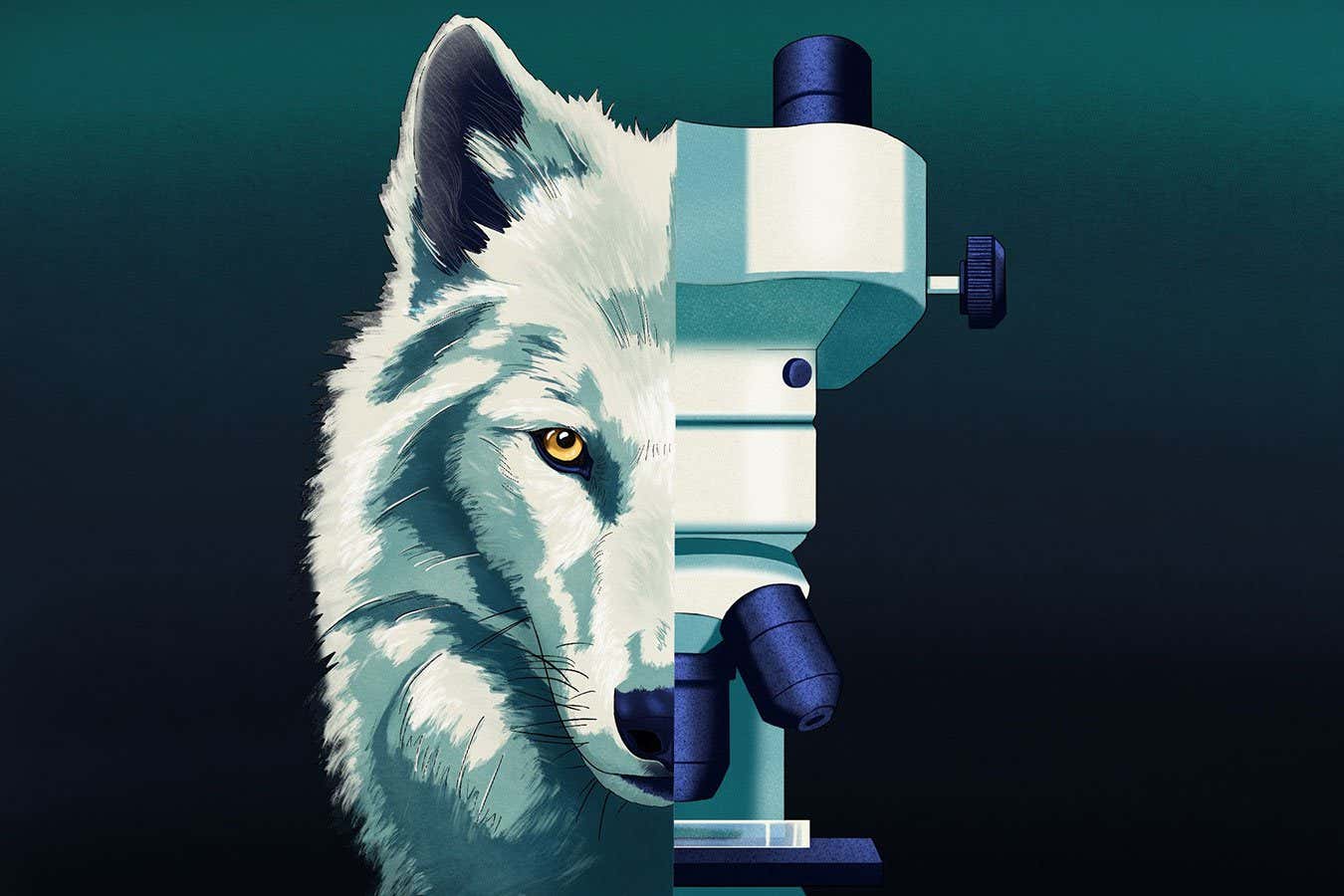
Dire wolves were massive and highly intelligent animals nearly the size of a small horse, capable of ripping a man’s arm off as easily as a dog kills a rat. They lived in cold regions in a place called Westeros… oh sorry, I’m getting confused with the fictional dire wolves in the Game of Thrones TV series.
The dire wolves that actually lived on Earth were no larger than today’s biggest grey wolves, but with a sturdier build, bigger teeth and larger bacula, or penis bones. They probably feasted on now-extinct megafauna such as giant ground sloths. After thriving for many millennia, they went extinct around 10,000 years ago.
But now they are back. At least, a company called Colossal Biosciences is claiming the dire wolf is the first species to be brought back from the dead. It isn’t the only animal being targeted for resurrection. Plans are afoot to do the same for the dodo, woolly mammoth, passenger pigeon, moa and more. But is it really possible to revive an extinct species? Such efforts also raise the question of whether – beyond the obvious appeal of seeing long-lost animals in the flesh – there are any good reasons to try this, and why organisations such as Colossal are spending vast amounts of money on it.
The idea of resurrecting an extinct species goes back at least a century. In Germany in the 1920s, there were attempts to recreate the extinct wild cattle known as aurochs through the selective breeding of their descendants, domesticated cattle – in part because it was thought cattle had been weakened by domestication. The result was an animal that looked a bit like a smaller aurochs. In the 1980s, there was a similar effort to breed zebras with the same coats as the quagga, an extinct subspecies of the stripe-covered plains zebra, which resulted in quagga-like specimens that lacked stripes on their hindquarters.
“But I don’t think you can claim that that’s a quagga,” says Claudio Sillero at the University of Oxford. Breeding can create animals that physically resemble quaggas or aurochs, but genetically they aren’t the same, he says.
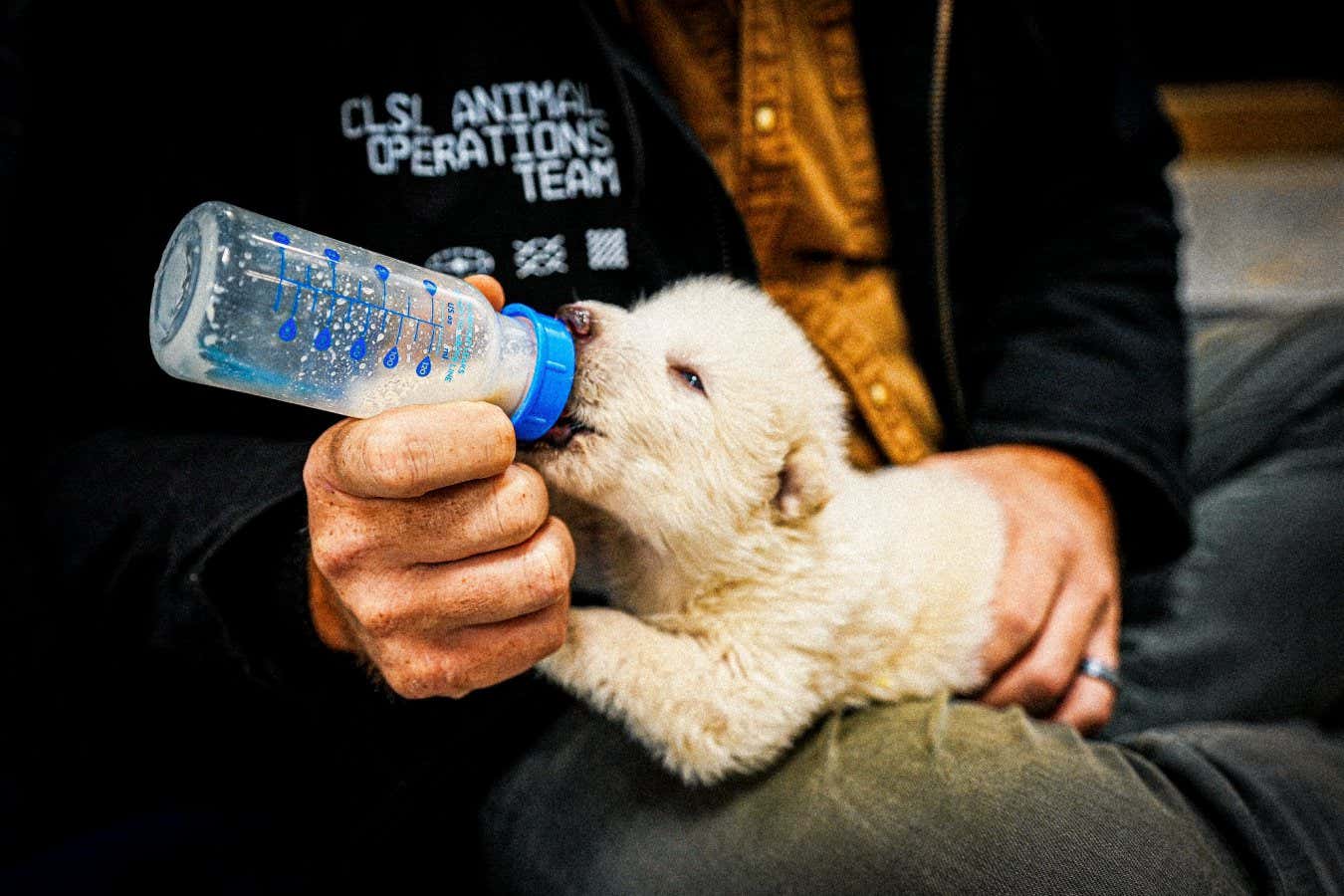
One of the “dire wolves” created by Colossal Biosciences, at 15 days old
Colossal Biosciences
These days, however, there are alternatives to selective breeding. What if you could get hold of the DNA from an extinct animal, put it in a living cell and create a clone of that long-dead individual? This, of course, is the idea that captured the public imagination when it was featured in the 1993 movie Jurassic Park. There is no formal scientific definition of “de-extinction”, but this scenario – creating an identical copy of a long-extinct animal – is what many people understand by the term.
It is also supposed to be impossible. “None of the current pathways will result in a faithful replica of any extinct species, due to genetic, epigenetic, behavioural, physiological, and other differences,” declared a 2016 report on de-extinction by the International Union for Conservation of Nature (IUCN).
Defining de-extinction
“It’s about definition,” says Tom Gilbert at the University of Copenhagen in Denmark. “If your definition of de-extinction is bringing back an extinct animal, exactly – genomically – like the extinct form, then yes it’s likely impossible.” That is because for the vast majority of extinct animals, there is no way to recover a complete genome. There are always going to be gaps resulting from the degradation of DNA over time.
However, there may be a few exceptions where animals went extinct very recently and we have well-preserved cells. In fact, in 2020 the US non-profit Revive & Restore used the cryopreserved cells of a black-footed ferret that died in 1988 to create three living ferrets that are clones of that long-dead individual. It did this by transferring the intact DNA from the frozen cells into living eggs.
“That’s literal resurrection,” says Ben Novak of Revive & Restore. “We’ve resurrected extinct gene variants for an endangered species.”
It isn’t de-extinction, however, because black-footed ferrets never died out completely. But at one point, there were just seven related individuals left, so cloning a non-related specimen massively boosted genetic diversity and, in turn, the species’ survival prospects.
There have been a few attempts to revive extinct species using this kind of cloning. For instance, the last remaining bucardo – a subspecies of the Iberian mountain goat – died in 2000 after a tree fell on her. Her cells were cloned, and a bucardo was born in 2003 – but it lived for just 10 minutes, probably because of health issues related to cloning.
This is the closest we have got to true de-extinction, but even if the clone had survived, it wouldn’t have been 100 per cent bucardo. A tiny proportion of its DNA came from the egg donor, in the form of cell organelles called mitochondria. And with no male bucardos – so no Y chromosome – there would have been no way to establish a pure breeding population.
We have cryopreserved samples of only a few other extinct species, such as the gastric-brooding frogs Rheobatrachus silus and R. vitellinus. These frogs, which incubate their eggs in their stomachs, died out soon after their discovery in Queensland in the 1970s. So far, efforts to clone them have been unsuccessful.
For extinct species where there are no cryopreserved cells, the only option is to turn to DNA preserved in bones and teeth, and sometimes in frozen tissues found in permafrost. Last year, for instance, Colossal claimed to have obtained from a tooth a near-complete genome sequence of the thylacine, the Australian carnivorous marsupial (also called a Tasmanian tiger) that went extinct in 1936. We don’t yet have the technology to turn that sequence on a computer back into DNA in a living cell, but it should become doable in the future.
Dinosaur resurrection?
Because DNA breaks up over time, the longer ago a species went extinct, the more fragmentary any genetic sequence we can retrieve will be. This means there is no chance of creating exact clones of animals that went extinct much more than a century or so ago. And the most ancient DNA fragments sequenced so far are just 2 million years old. So, sorry kids: no dinosaurs.
With species that went extinct long ago, the question is not only whether we can revive them, but also whether we should even try. After all, the world these animals lived in is long gone.
These kinds of issues were explored in the 2016 IUCN report. It concluded that we should try to recreate a lost species only when there is a conservation benefit, such as restoring an ecosystem in which the animal had played a key role.
For this purpose, it doesn’t matter if a revived animal is an exact copy of the extinct one, as long as it does much the same thing. In the jargon, this is called “creating a proxy of an extinct species for conservation benefit”, and this is what some biologists mean when they use the term de-extinction. But creating an ecological proxy is a very different thing from Jurassic Park-style de-extinction.
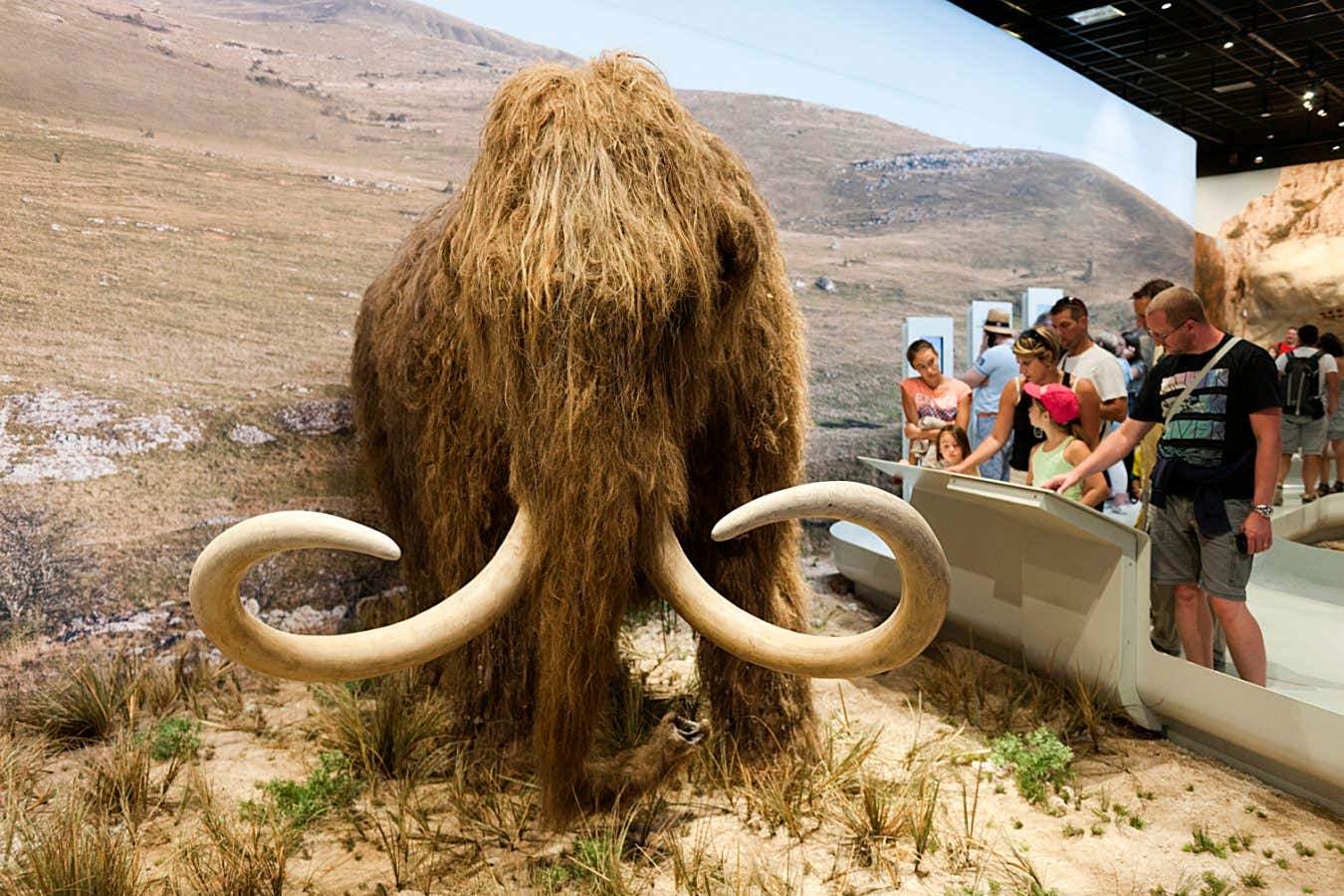
A model of a woolly mammoth at the Pont d’Arc Cave in France
Jean-Marc ZAORSKI/Gamma-Rapho via Getty Images
In fact, for many purposes, living species are good-enough proxies. “We should always reach first to extant species as potential ecological replacements,” says Philip Seddon at the University of Otago in New Zealand, who helped write the 2016 IUCN report.
So are the various de-extinction projects justified, according to this criterion of conservation benefit? Take aurochs, the extinct wild cattle.
Large herbivores like this have an immense effect on landscapes, says Claus Kropp of the Auerrind Project in Germany. The huge quantities of dung they drop set off chain reactions involving many other animals and plants, and the deep hoofprints they leave in wet mud create habitats for animals such as frogs.
Aurochs revival
The cattle created in the 1920s breeding project, however, aren’t even half the size of aurochs, says Kropp. So the Auerrind Project is again trying to recreate them via conventional breeding, but this time it has a better idea of what it is aiming for, given that we now have partial genome sequences from dozens of ancient aurochs. There is a similar project under way in the Netherlands.
Can’t existing large cattle breeds do the same? Most modern breeds aren’t suited to living outdoors year-round, says Kropp, and they also lack the forward-facing horns that helped aurochs defend themselves against predators. “We want to use the animals in regions where we have wolves,” he says. “We want to give them the best possible chance.”
Then there is the plan by Revive & Restore to create a bird that behaves like the extinct passenger pigeon. This will be done by modifying its closest living relative, the band-tailed pigeon.
Before they were wiped out, enormous flocks of passenger pigeons could deposit inches of guano on forest floors when they roosted in the trees above, says Novak. The thinking is that these disturbances shaped the nature of forests and boosted biodiversity.
“Even though there’s lots of forest again today [in the eastern US], the composition of that forest is very different than it was in the past,” he says. “We’re starting an experiment in the next four to six weeks where we’re going to spread guano on a forest site in Wisconsin, and then analyse that over some years.”
The team estimates there is enough forest to support 2 billion passenger pigeon-like birds, says Novak – though whether people would welcome the return of such vast flocks is questionable.

Plans are afoot to revive the extinct passenger pigeon using genetic engineering
Chronicle/Alamy
Achieving this will be a huge technical challenge. For starters, modifying birds is especially difficult because no one has found a way to locate the DNA inside the giant cell that is the yolk of an egg – a problem Colossal will also face with its plan, announced on 8 July, to “de-extinct” New Zealand’s giant wingless birds called moas.
Then there are the 25 million differences between the genomes of the band-tailed and passenger pigeons, says Novak, though he hopes only thousands of changes will be needed to recreate their key characteristics. The plan is to swap large segments of the band-tailed pigeon’s genome with the equivalent parts of the passenger pigeon genome. These chunks will be chosen because they contain gene variants thought to be important to the behaviour of passenger pigeons, but the hope is that many of the other variants on them will turn out to play a role too.
“We don’t necessarily know what all these mutations are doing, so our thought is, let’s just get more in there,” says Novak. “Let’s say we only make a dozen changes, but they’re all 100,000 base pairs in size; we will have accomplished tens of thousands of mutations that way.”
Even if the project succeeds, scientifically the result will be a kind of hybrid between the band-tailed pigeon (Patagioenas fasciata) and the passenger pigeon (Ectopistes migratorius). For this reason, Novak has proposed the name Patagioenas neoectopistes: the “new wandering pigeon of America”.
While Revive & Restore does sometimes talk about “bringing back the passenger pigeon” for the sake of ease, Novak is clear that recreating it isn’t possible: “We cannot resurrect the original passenger pigeon. It’s extinct.”
Dire wolves back from the dead?
In contrast, Colossal’s attempt to make grey wolves more like dire wolves was much less ambitious. There are millions of differences between the two species, but the company made just 20 small changes to the genome of grey wolf cells, only 15 of which are based on the dire wolf genome. The altered cells were then cloned, resulting in the birth of three gene-edited grey wolves.
The 20 changes are intended to make the animals larger and more muscular, and their fur longer and white, rather like the dire wolves depicted in Game of Thrones. (The TV series was mentioned three times in the 7 April press release from Colossal.) It won’t be clear until the three animals are fully grown how successful the attempt to change their shape was, says Colossal’s chief scientist Beth Shapiro. “We have to wait until they’re older to get the scans that we need.”
However, rather than describing these animals as a kind of hybrid, as Novak plans to do for the pigeons, Colossal continues to claim they are “the world’s first successfully de-extincted animal”.
“With those edits, we have brought back the dire wolf. We have been using the concept of functional de-extinction from the beginning, and that is what Colossal achieved,” the company said in a statement to New Scientist.
But not only are these gene-edited wolves very far from being exact genetic copies of dire wolves, there is also no evidence they can perform an ecological role that’s different from grey wolves’. Even if they could, with no megafauna larger than bison left, there is no gap for them to fill. What’s more, Colossal has no plans to release the gene-edited grey wolves – one of the many potential issues is that they could interbreed with normal grey wolves.
The scientific verdict is clear. The three animals produced by Colossal are not dire wolves
The scientific verdict is clear. “The three animals produced by Colossal are not dire wolves. Nor are they proxies of the dire wolf,” said a statement put out by the IUCN’s expert group on canids.
By swapping more chunks of the grey wolf genome for dire wolf ones, as Novak plans to do with the pigeons, it would be possible to create “hybrids” that have more dire wolf DNA than the three modified grey wolves. With enough effort, it might even be possible to create hybrids that are closer to dire wolves than grey wolves. But with Colossal claiming the task of reviving the dire wolf has already been achieved, it seems unlikely for the company to do this.
Woolly mammoth de-extinction plans
The issues with Colossal’s plans to “de-extinct” the woolly mammoth by modifying elephants are similar to those with the dire wolf. Again, the result will be some kind of hybrid between elephants and mammoths – probably more elephant than mammoth – and the need for them is unclear.
Proponents often say large herbivores could help slow the loss of permafrost in parts of the Arctic. Indeed, one small study found that permafrost stays colder when large animals flatten snow, so it no longer acts as a thick blanket insulating the ground from the cold air above.
But horses could also do the job, says Richard Grenyer at the University of Oxford. “There’s very good science suggesting you don’t need mammoths,” he says. “And the biggest problem is the scale. The sheer amount of land required to make any difference [climate-wise] is beyond anything we’ve ever seen in any conservation project.”
There is also the question of why a for-profit company like Colossal is putting so much effort into de-extinction. How is it going to make back the vast sums it is spending? Grenyer, for one, can’t see how the company can do this from de-extinction alone. He suspects that this is more about developing new technologies than de-extinction, and that the dire wolf project is just a showcase for the company’s genetic modification skills.
“This isn’t a de-extinction business; they won’t be bringing a whole thing back from the dead ever because that’s not what they do,” suggests Grenyer. Colossal, of course, claims it has already done exactly that.
The company makes no secret of the fact that it aims to profit from spin-off applications. It says its research could lead to advances in everything from IVF and drug discovery to regenerative medicine and “genetic enhancements”. “We have a 17-person team that’s working on a fully exogenous artificial womb that could have broad application,” says Shapiro.
All the biologists New Scientist spoke to for this article agree the company is making significant advances. But if you are hoping for Jurassic Park, your best bet is still the movie version.
Topics:
Source link : https://www.newscientist.com/article/2486422-the-truth-about-de-extinction-is-it-even-possible-and-why-do-it/?utm_campaign=RSS%7CNSNS&utm_source=NSNS&utm_medium=RSS&utm_content=home
Author :
Publish date : 2025-07-14 16:00:00
Copyright for syndicated content belongs to the linked Source.

